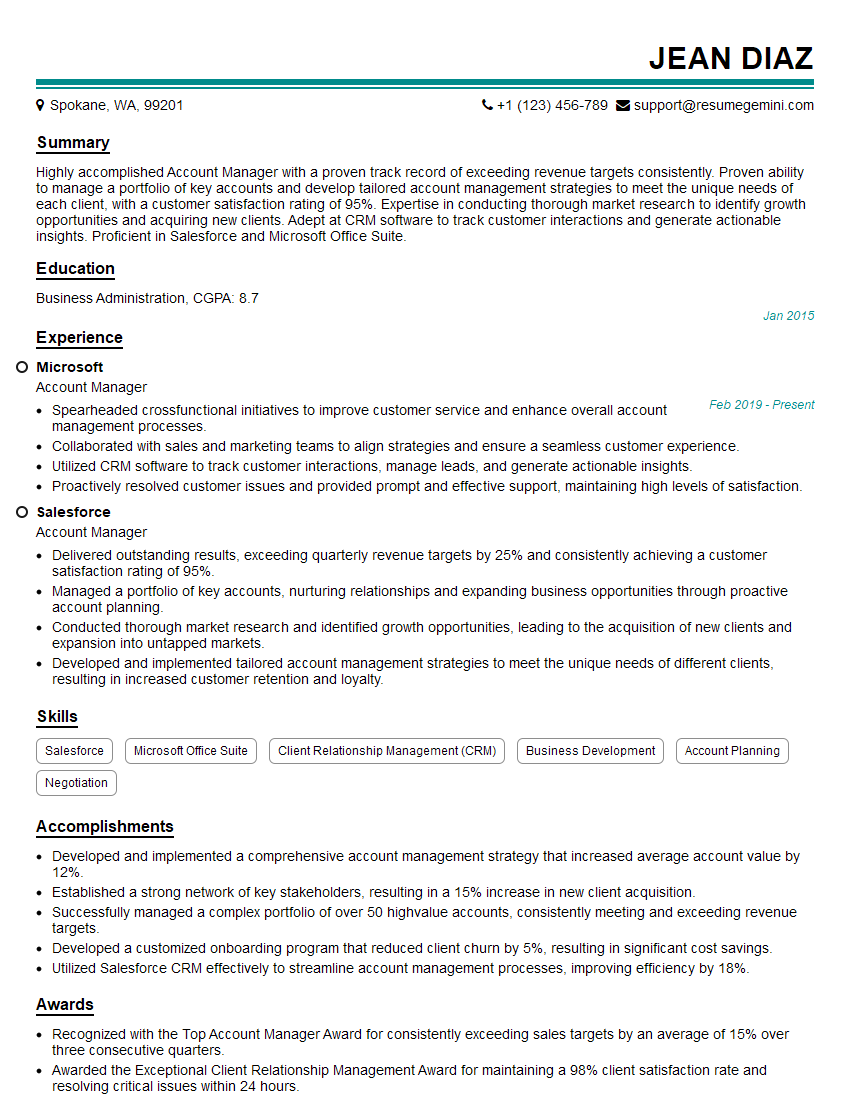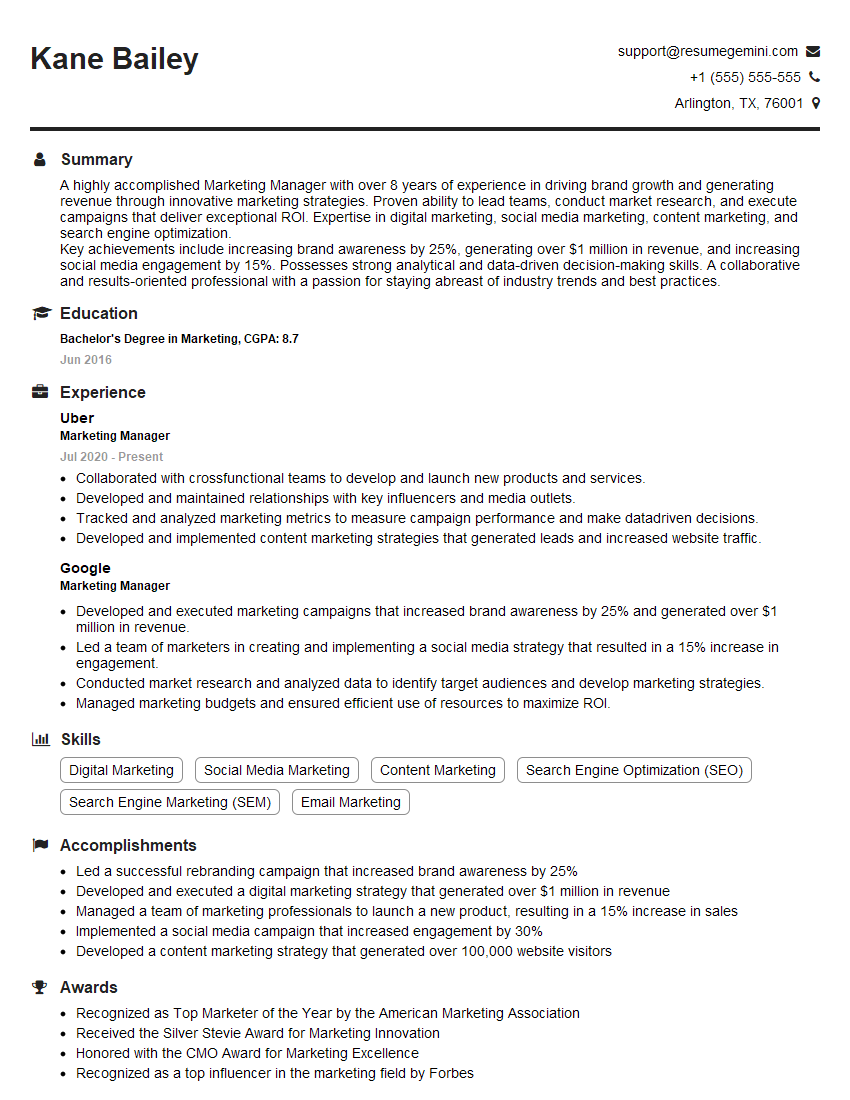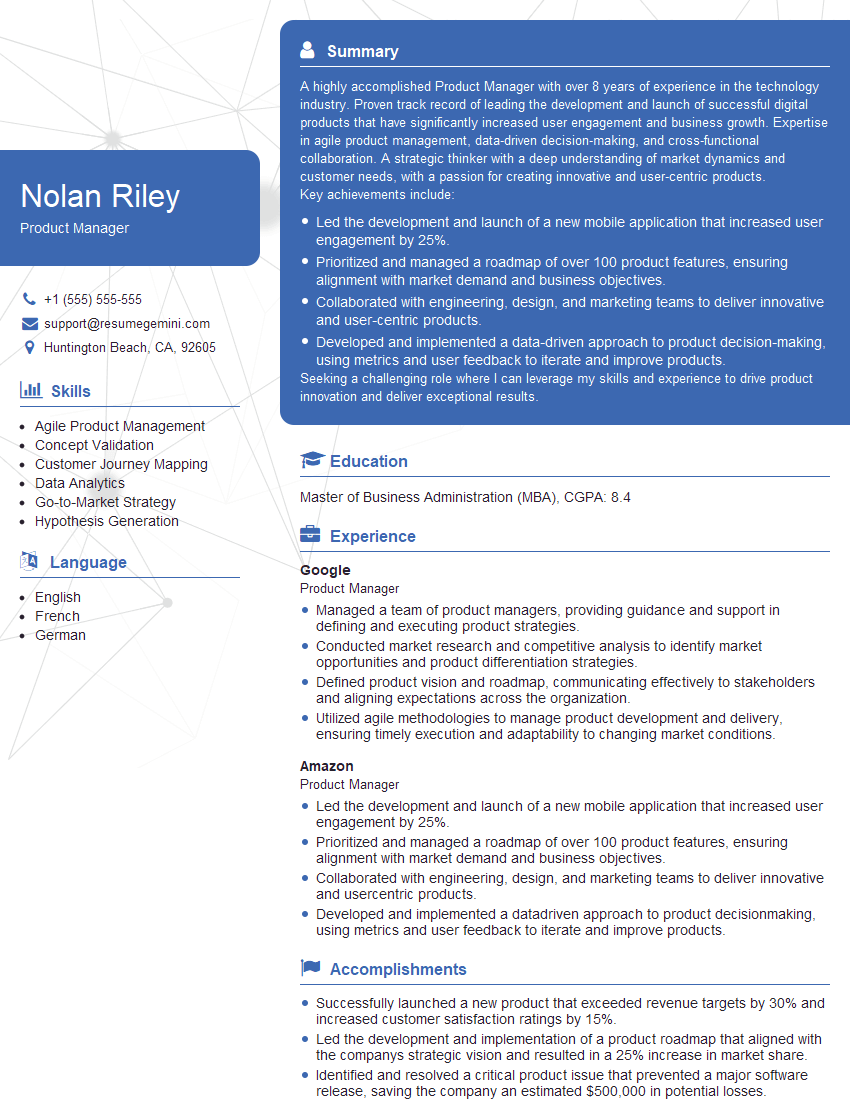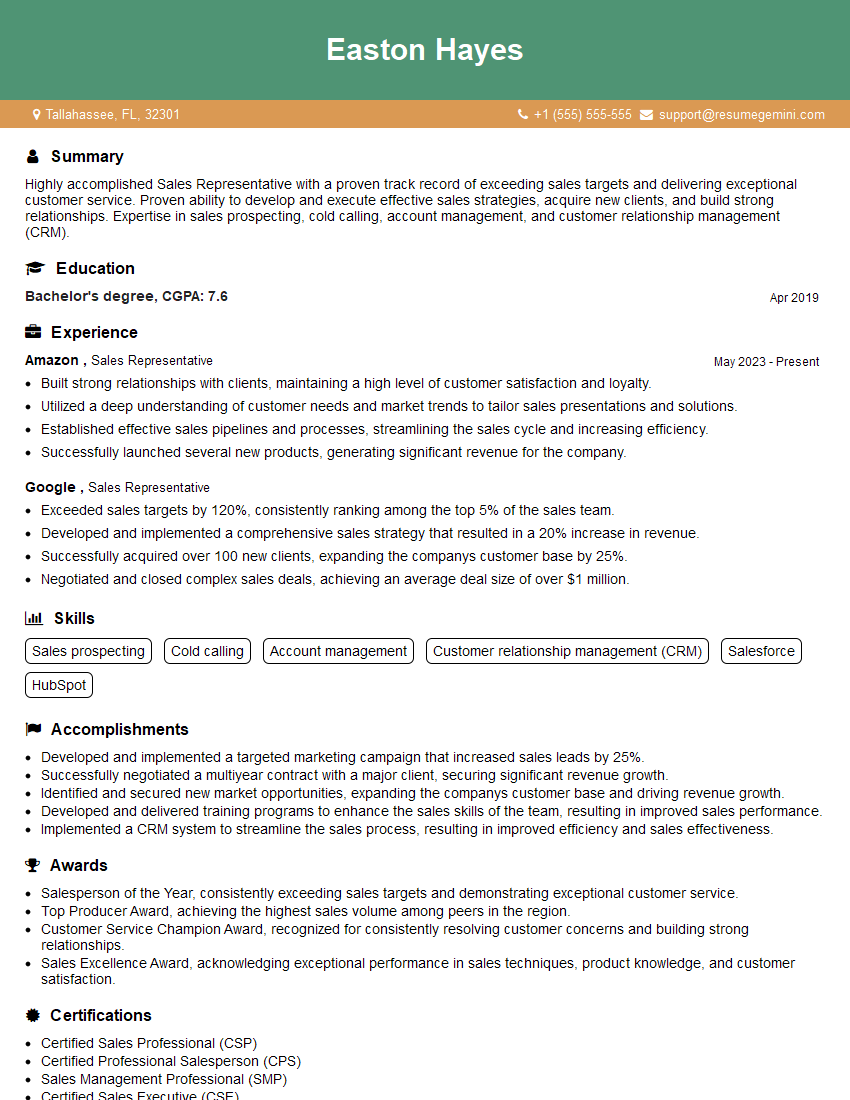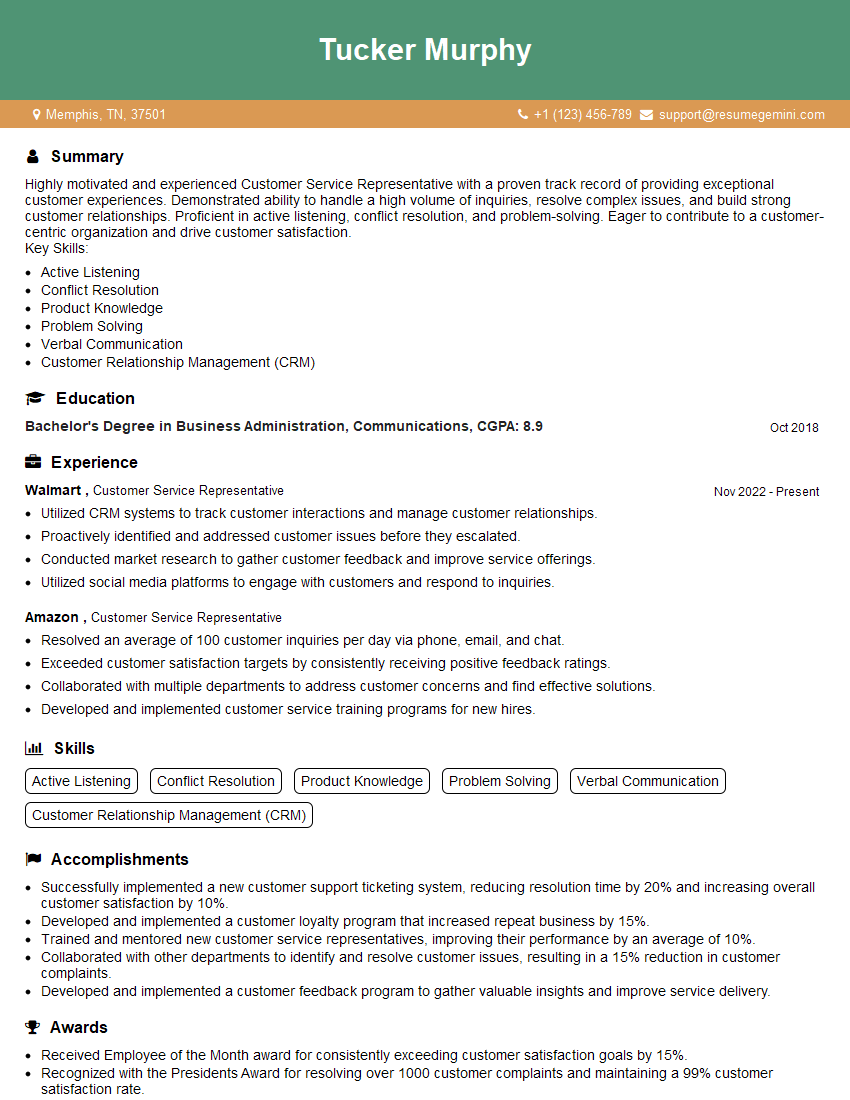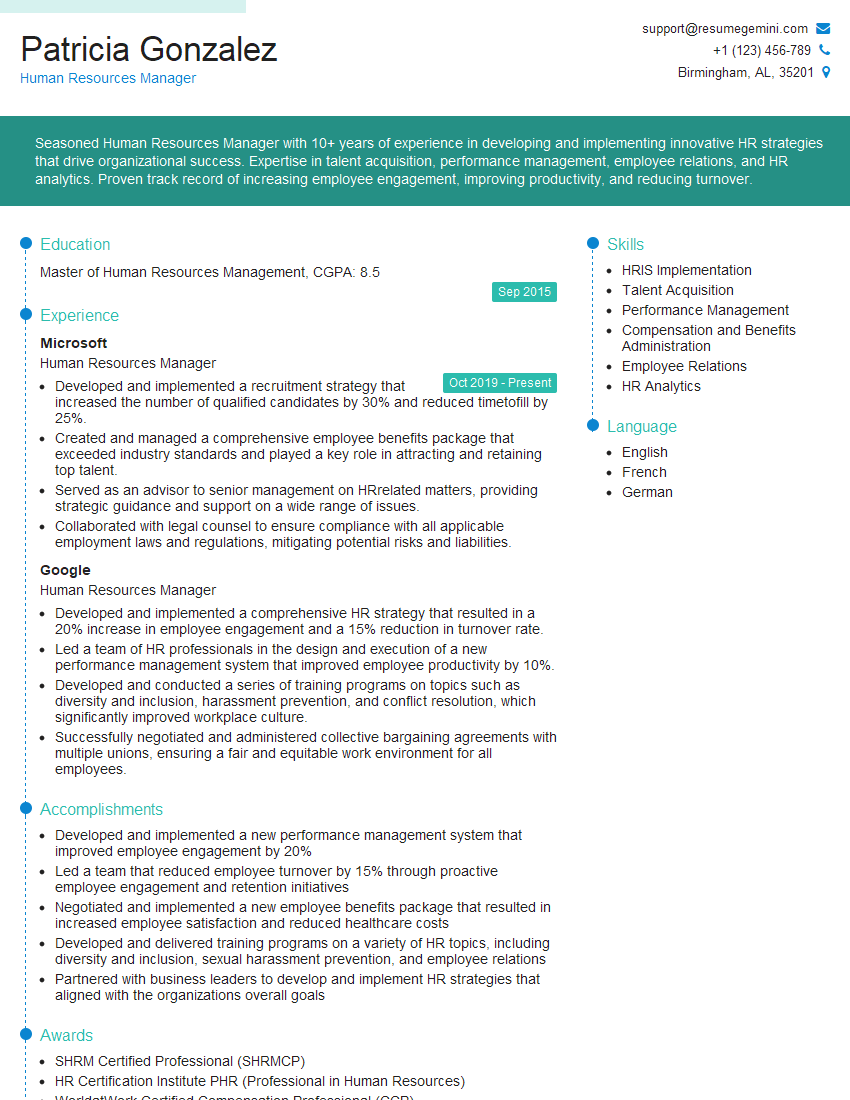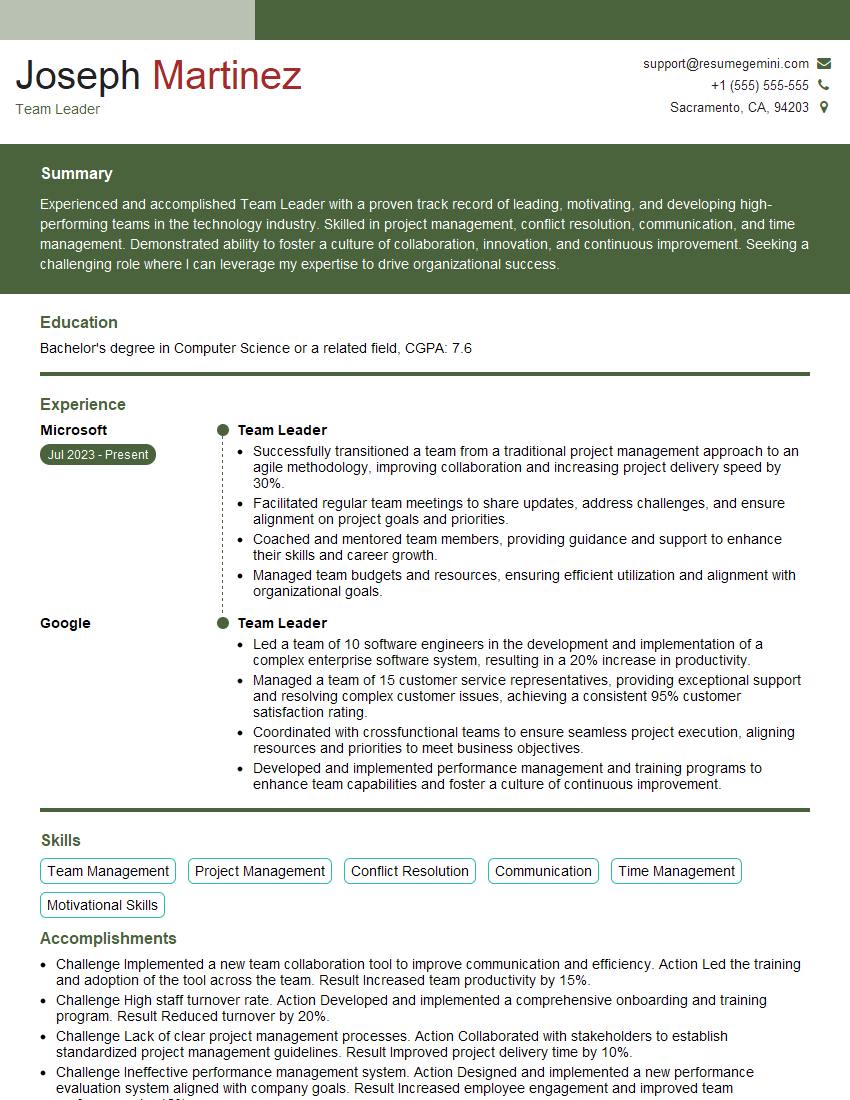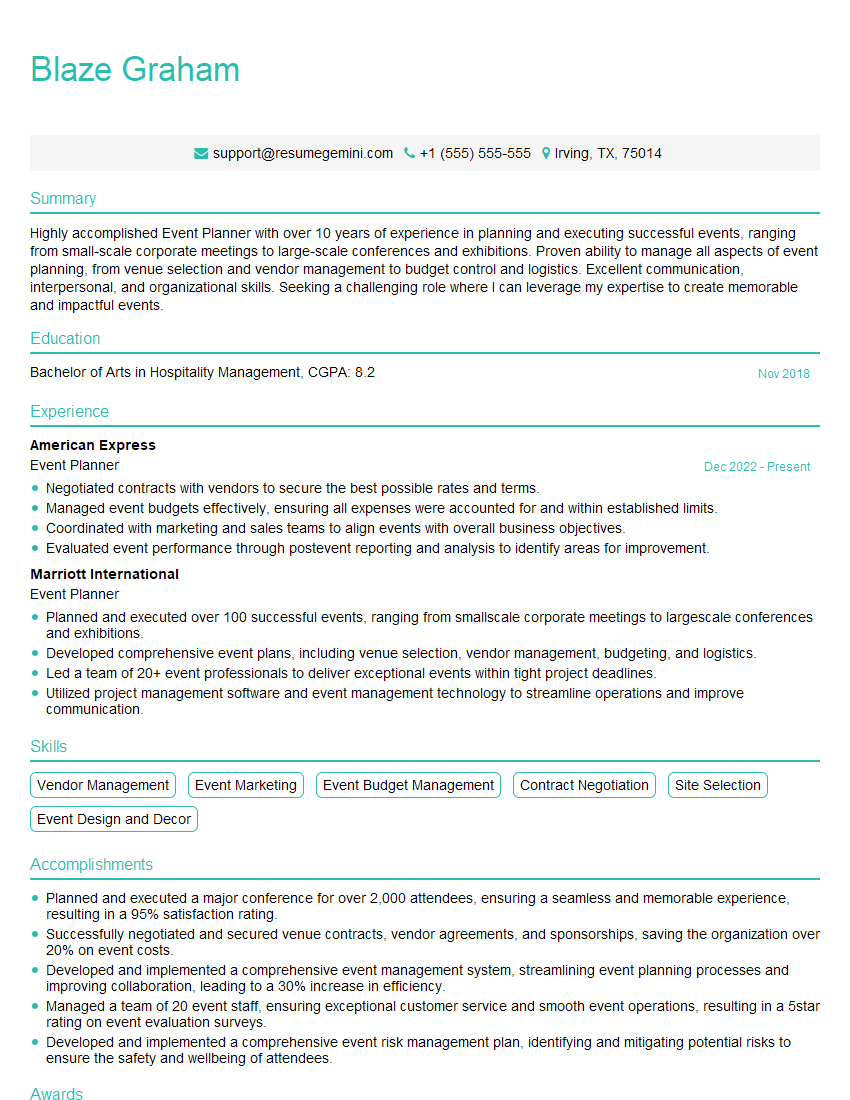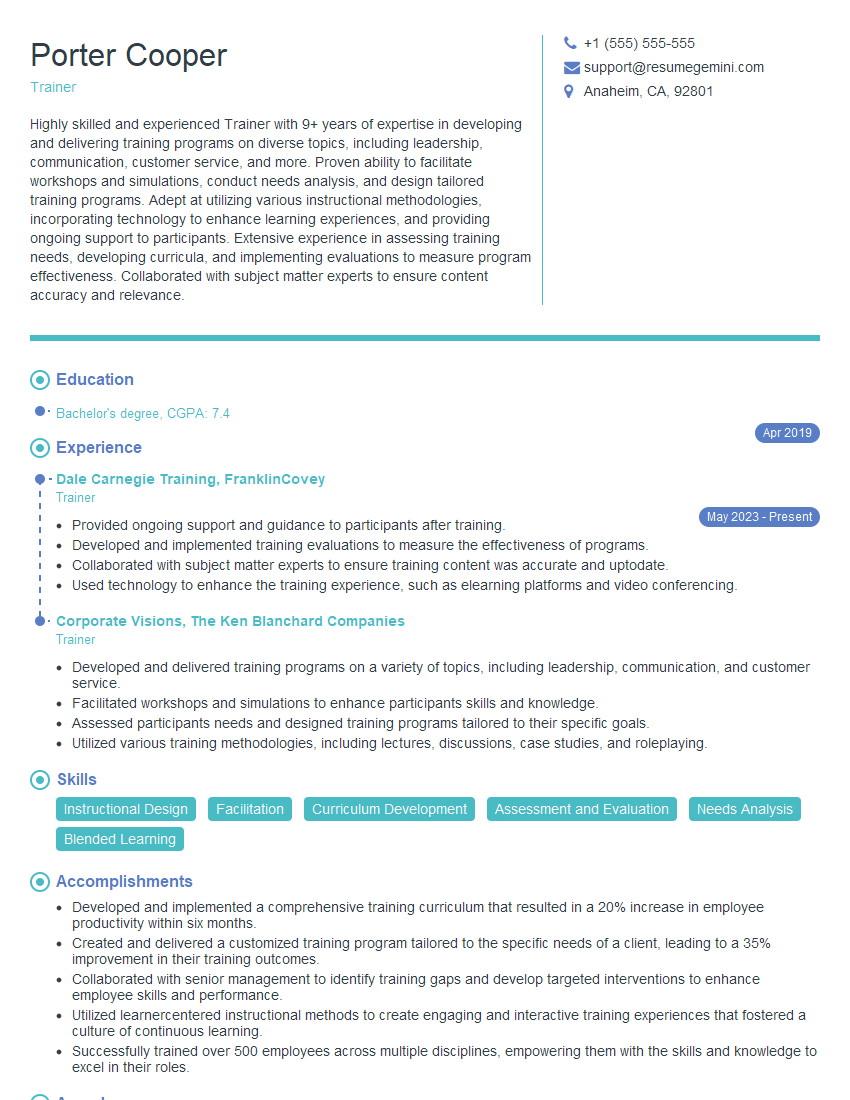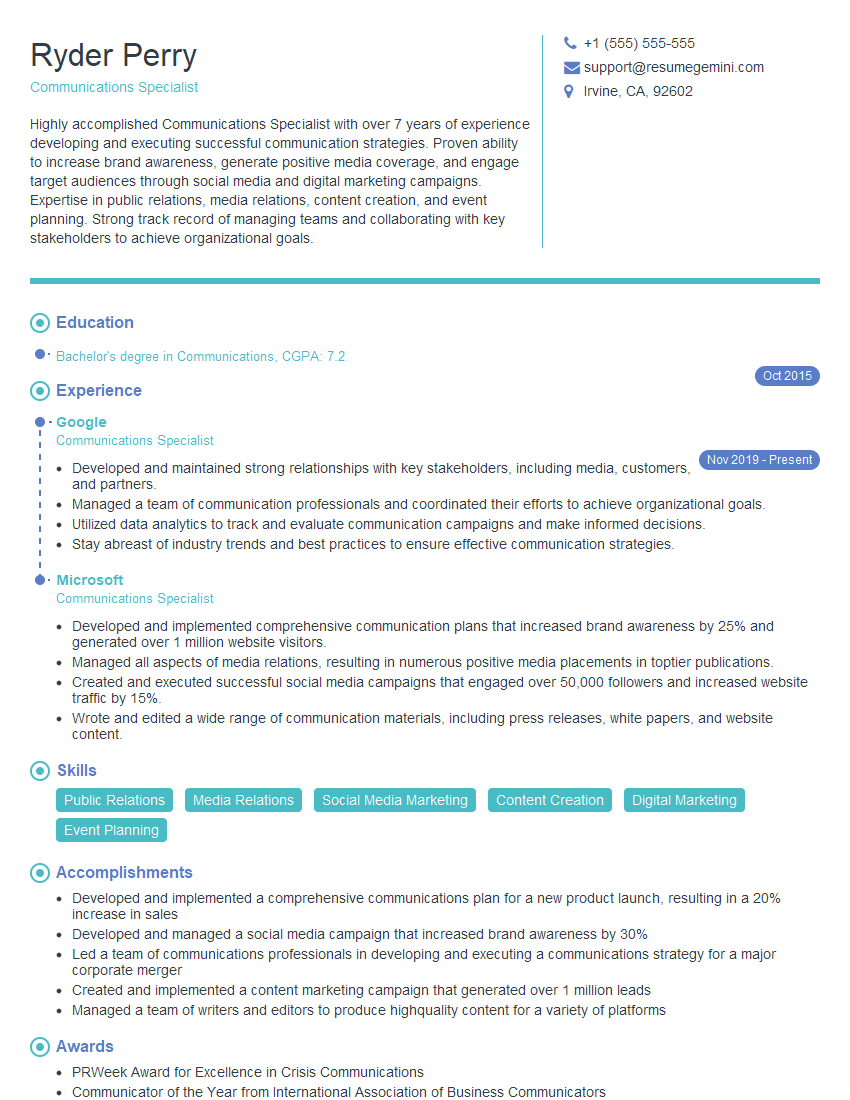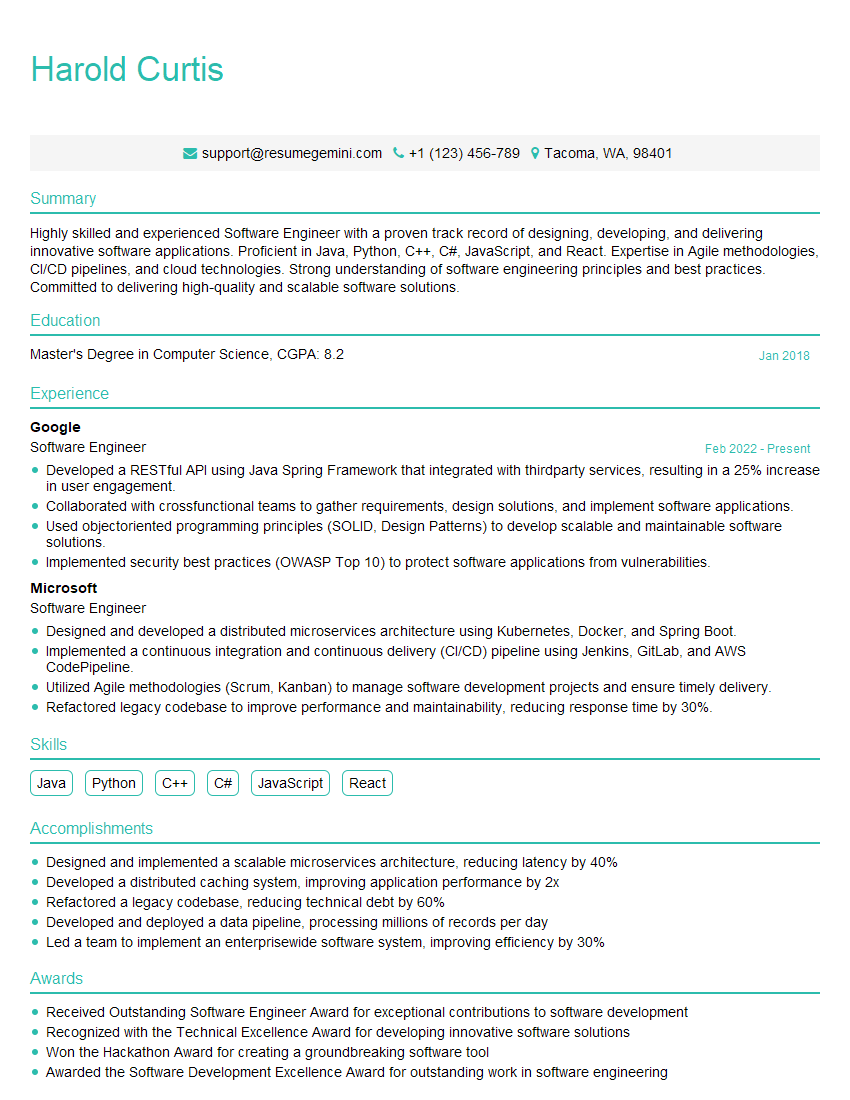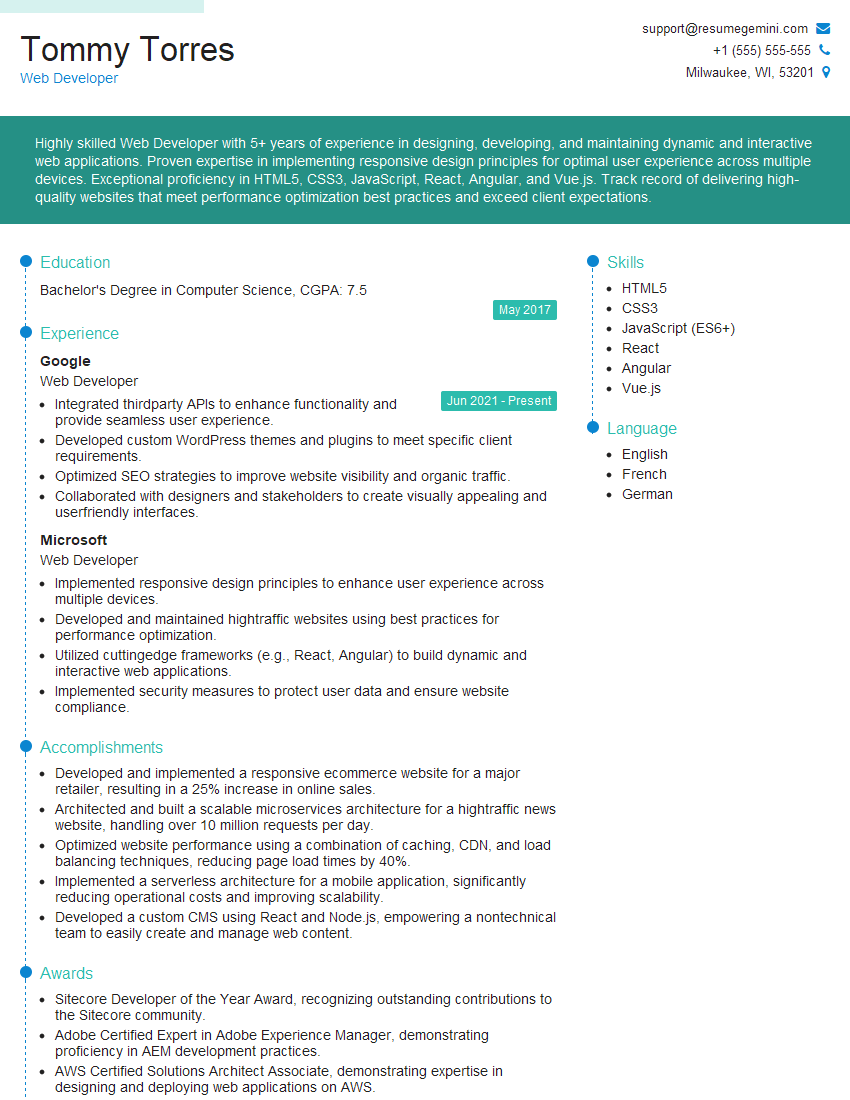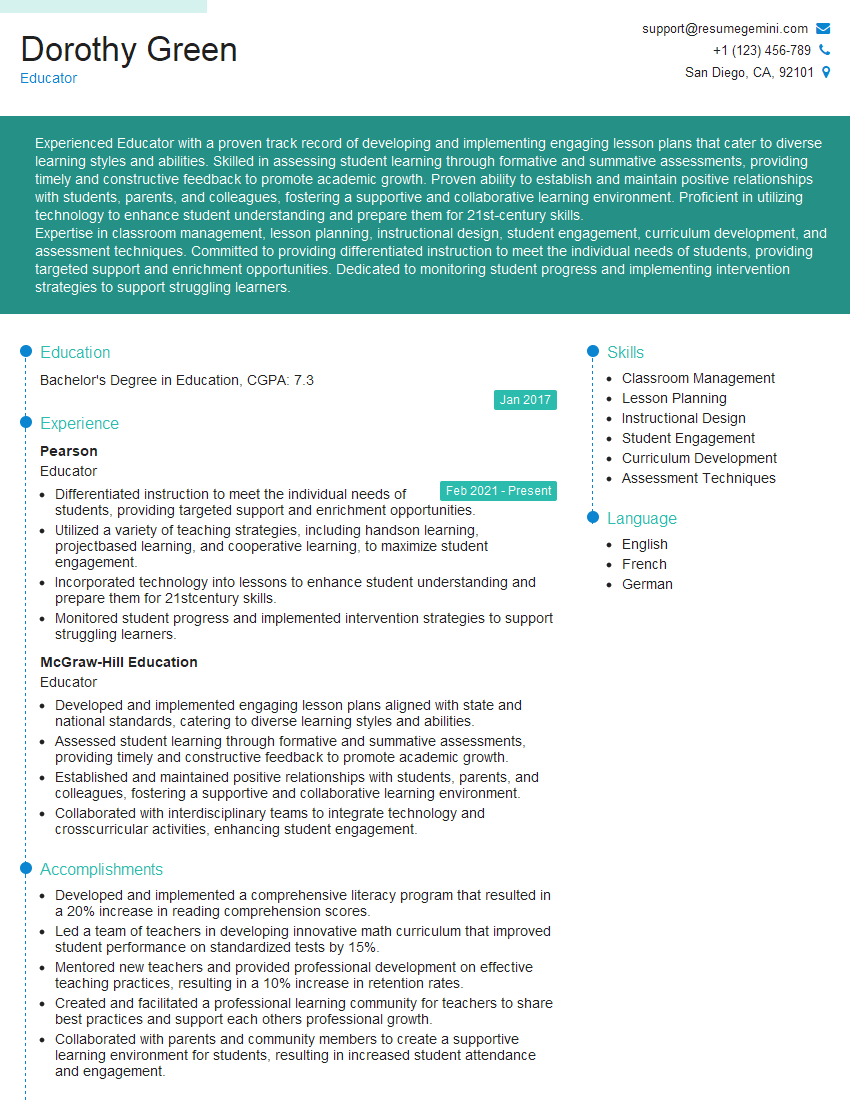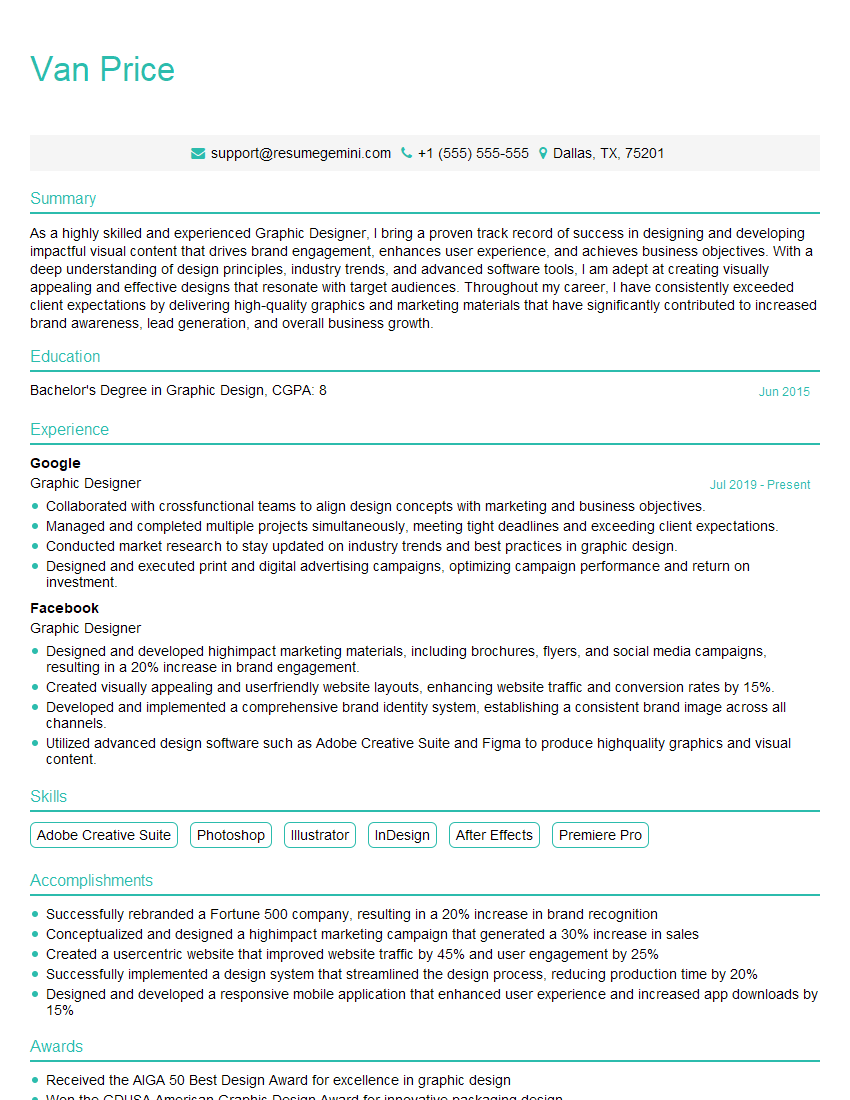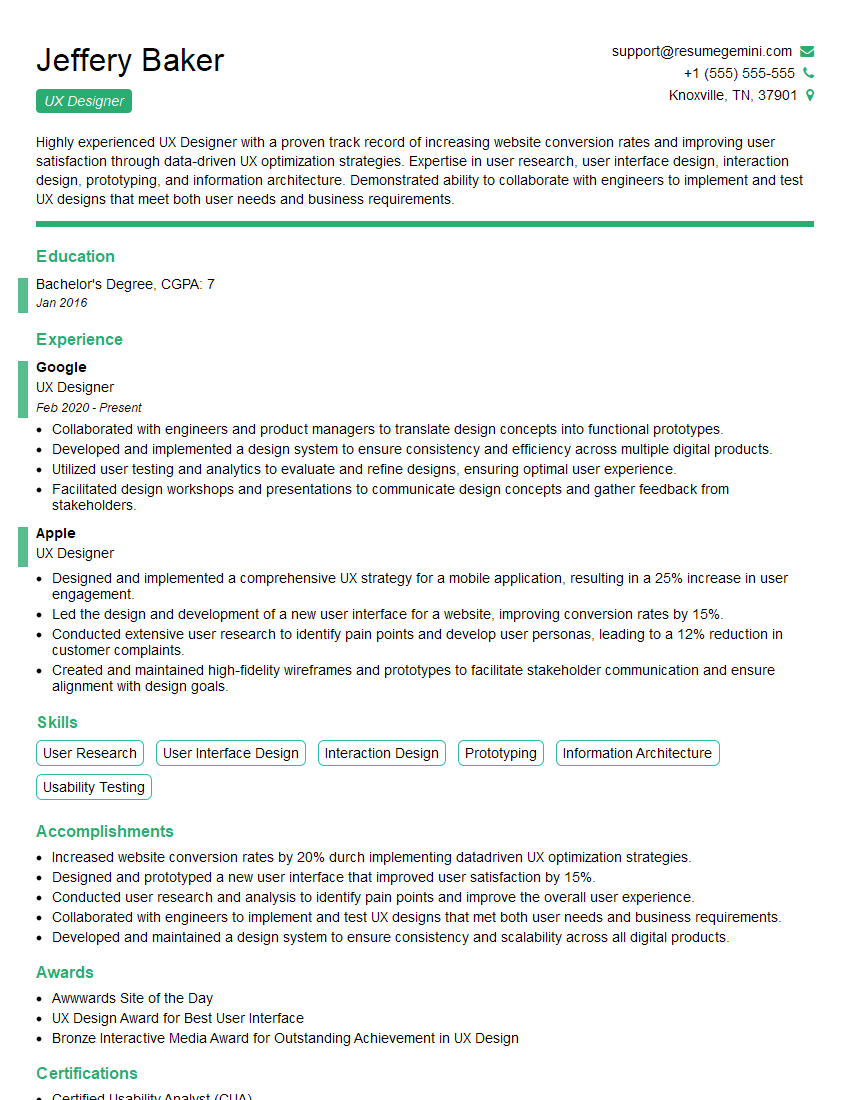Preparation is the key to success in any interview. In this post, we’ll explore crucial Soft Skills (e.g., communication, teamwork, problem-solving) interview questions and equip you with strategies to craft impactful answers. Whether you’re a beginner or a pro, these tips will elevate your preparation.
Questions Asked in Soft Skills (e.g., communication, teamwork, problem-solving) Interview
Q 1. Describe a situation where you had to communicate complex information to a non-technical audience.
Communicating complex information to a non-technical audience requires a shift from technical jargon to clear, concise language. It’s about translating technical concepts into relatable analogies and avoiding overwhelming the listener with details.
In a previous role, I had to explain the intricacies of our new data encryption process to the marketing team. Instead of diving into algorithms and cryptographic keys, I started by explaining the core concept: protecting sensitive customer information. I used the analogy of a strong lock and key to represent encryption, making it easily understandable. I then used visuals like a simple flowchart to illustrate the process step-by-step, avoiding technical jargon. I also encouraged questions and made sure to reiterate key points throughout the presentation to ensure comprehension.
This approach ensured the marketing team understood the importance of the encryption process without getting bogged down in the technical details. Post-presentation, I sent a concise summary email with key takeaways, reinforcing the learning.
Q 2. How do you handle conflict within a team?
Conflict is inevitable in teamwork, but how it’s handled determines team effectiveness. My approach focuses on proactive communication and collaborative problem-solving. I believe in addressing conflicts directly but respectfully, focusing on the issue at hand rather than resorting to personal attacks.
For example, during a project, two team members had conflicting ideas on the design approach. Instead of letting the disagreement escalate, I facilitated a meeting where each member explained their perspective. We then worked together, brainstorming solutions that incorporated the best aspects of each approach. This collaborative process not only resolved the immediate conflict but also strengthened the team’s trust and communication.
My strategy involves actively listening to all parties involved, identifying the root cause of the conflict, and then working collaboratively to find a mutually agreeable solution. I encourage open communication and seek to find a win-win outcome whenever possible.
Q 3. Explain your approach to problem-solving, using a specific example.
My problem-solving approach follows a structured process: Define, Analyze, Brainstorm, Implement, and Evaluate.
- Define the problem: Clearly state the problem and its impact.
- Analyze the problem: Gather information, identify contributing factors, and analyze the root cause.
- Brainstorm solutions: Generate multiple potential solutions, considering different perspectives.
- Implement the solution: Choose the best solution and implement it.
- Evaluate the results: Assess the effectiveness of the solution and make adjustments if necessary.
For example, when our website experienced a sudden drop in traffic, I followed this process. I first defined the problem (reduced website traffic), then analyzed potential causes (server issues, SEO problems, external factors). I brainstormed solutions (checking server logs, analyzing SEO performance, checking competitor activities). After implementing solutions that addressed identified SEO issues, I evaluated the results, seeing a subsequent increase in traffic. This iterative approach allows for adaptation and continuous improvement.
Q 4. Describe a time you had to adapt to a changing work environment.
Adaptability is crucial in today’s dynamic work environment. My approach focuses on continuous learning, open communication, and a proactive mindset.
When our company transitioned to a new project management software, I embraced the change by actively seeking training opportunities and reaching out to colleagues for assistance. I understood that resistance to change would only hinder my productivity, so I approached it with curiosity and a willingness to learn. I also volunteered to be a mentor to others who were struggling to adapt to the new system. This proactive approach not only helped me to master the new software quickly, but also strengthened my relationships with my colleagues.
I believe that adaptability involves actively seeking out information, asking questions, and being open to new ways of working. It’s not just about accepting change; it’s about proactively integrating it into your workflow to achieve optimal results.
Q 5. How do you prioritize tasks when working on multiple projects simultaneously?
Prioritizing tasks effectively when juggling multiple projects requires a strategic approach. I typically use a combination of methods: Eisenhower Matrix (urgent/important), project deadlines, and dependency analysis.
I start by identifying all tasks and their deadlines. Then, I use the Eisenhower Matrix to categorize tasks based on urgency and importance. Urgent and important tasks are tackled immediately. Important but not urgent tasks are scheduled. Tasks that are neither urgent nor important are delegated or eliminated. Finally, I analyze task dependencies to ensure efficient workflow; tasks that depend on others are sequenced accordingly.
This approach allows me to maintain focus on high-priority tasks while ensuring timely completion of all projects. Regular review and adjustment of priorities are essential to maintain this efficiency.
Q 6. Give an example of a time you had to persuade someone to your point of view.
Persuasion involves understanding the other person’s perspective and presenting your point of view in a compelling and logical manner.
During a project, I had to persuade a client to adopt a more efficient design solution, which differed from their initial preference. I started by actively listening to their concerns, acknowledging their initial ideas, and then presenting data and evidence supporting my proposed solution. I demonstrated how my approach would meet their goals more effectively and efficiently, while mitigating potential risks. I also emphasized the long-term benefits of the new design, highlighting its cost-effectiveness and scalability. By addressing their concerns and presenting a strong case, I was able to gain their agreement.
Successful persuasion requires empathy, strong communication skills, and a clear understanding of the other person’s needs and objectives.
Q 7. How do you build rapport with colleagues and clients?
Building rapport is essential for effective collaboration. It’s about establishing trust and mutual respect.
With colleagues, I focus on active listening, showing genuine interest in their work and perspectives, and offering support. I make an effort to learn about their interests outside of work, fostering a sense of camaraderie. With clients, I prioritize clear communication, understanding their needs, and delivering on my promises. I consistently demonstrate professionalism, reliability, and a genuine desire to help them achieve their goals. A small gesture like remembering details about their business or family demonstrates care and strengthens the relationship.
Building rapport is an ongoing process that requires consistent effort, empathy, and genuine interest in others. It’s about making others feel valued and understood.
Q 8. Describe a situation where you had to work effectively under pressure.
Working effectively under pressure is a crucial skill, especially in fast-paced environments. It involves maintaining composure, prioritizing tasks, and utilizing efficient problem-solving strategies. My approach focuses on staying calm, breaking down large tasks into smaller, manageable steps, and leveraging time management techniques.
For instance, during a previous project where we faced a tight deadline for a major software release, we encountered unexpected bugs in the final stages of testing. Instead of panicking, I initiated a quick team meeting to assess the situation. We prioritized the most critical bugs based on their impact and assigned them to team members with the relevant expertise. We also implemented a rigorous testing protocol to ensure the fixes didn’t introduce new problems. Through clear communication, effective delegation, and focused effort, we managed to resolve the issues and successfully met the deadline. This experience highlighted the importance of proactive planning, effective communication, and a calm, decisive approach under duress.
Q 9. How do you handle criticism or feedback?
Constructive criticism is invaluable for professional growth. My approach focuses on actively listening, seeking clarification if needed, and separating the message from the messenger. I avoid becoming defensive and instead concentrate on understanding the feedback’s intent. I then assess its validity, identifying areas where I can improve. If the criticism is valid, I implement changes and document them to track my progress. If the feedback seems subjective or unwarranted, I politely express my perspective while acknowledging their viewpoint.
For example, if I received feedback that my presentations lacked visual aids, I wouldn’t take it personally. Instead, I’d review my past presentations, analyze the feedback’s merit, and plan for incorporating visuals in future presentations to enhance clarity and audience engagement. The key is to approach criticism as an opportunity for learning and improvement, rather than a personal attack.
Q 10. How do you contribute to a positive team environment?
Contributing to a positive team environment is paramount for success. My contributions revolve around fostering open communication, mutual respect, and collaboration. I actively participate in team discussions, offering constructive feedback and actively listening to my colleagues’ ideas. I believe in celebrating team achievements, acknowledging individual contributions, and supporting team members facing challenges. I also strive to maintain a positive and encouraging attitude, even during stressful situations.
In a previous project, I noticed a team member struggling with a particularly complex task. I offered my assistance, not by taking over, but by providing guidance, sharing relevant resources, and offering encouragement. By fostering a collaborative and supportive environment, we not only completed the task successfully but also strengthened the team bond. This highlights the importance of empathy, collaboration, and active support in building a positive team dynamic.
Q 11. Describe your approach to time management.
Effective time management is a cornerstone of productivity. My approach is based on a combination of planning, prioritization, and execution. I typically begin by creating a to-do list, breaking down large tasks into smaller, manageable steps. I then prioritize these tasks based on urgency and importance using methods like the Eisenhower Matrix (urgent/important). I allocate specific time slots for each task, considering potential interruptions and buffer time. I regularly review my progress and adjust my schedule as needed, ensuring I stay on track and meet deadlines. Tools like project management software and calendar apps greatly aid in maintaining organization and tracking progress.
I find that setting realistic goals and avoiding procrastination are also crucial. Regular breaks and mindful self-care help maintain focus and prevent burnout, ultimately leading to increased efficiency and better results.
Q 12. How do you delegate tasks effectively?
Effective delegation is about entrusting tasks to the right individuals while maintaining oversight. It’s crucial to assess each team member’s skills, experience, and workload before delegating. Clearly defining the task, outlining expectations, and providing necessary resources are key steps. Regular check-ins to monitor progress, provide support, and address any challenges are essential to ensure successful completion. It’s also important to empower team members and trust their abilities to execute the tasks effectively. Micromanagement should be avoided to foster autonomy and ownership.
For instance, during a previous project, I delegated a specific module development to a junior developer who had shown interest and aptitude in that area. I provided him with clear guidelines, access to relevant resources, and scheduled regular check-ins. This approach not only helped complete the project efficiently but also provided the junior developer with valuable experience and growth opportunities. Successful delegation is not just about assigning work, but about empowering and supporting team members to thrive.
Q 13. Give an example of a time you had to make a difficult decision.
Difficult decisions often involve trade-offs and require careful consideration. One example involved choosing between two equally qualified candidates for a key team role. Both possessed excellent technical skills, but their leadership styles differed significantly. To make an informed decision, I thoroughly assessed their strengths and weaknesses, considered their alignment with the team’s culture and the project’s needs, and sought input from other team members. Ultimately, I chose the candidate whose leadership style better complemented the existing team dynamics and the project’s requirements, recognizing that while the other candidate was highly skilled, their approach may have created friction within the team.
This decision highlighted the importance of comprehensive assessment, collaboration, and aligning decisions with long-term goals. It’s crucial to be objective, consider various factors, and accept that sometimes difficult choices are necessary for the overall good of the team or organization.
Q 14. How do you ensure clear and concise communication in written form?
Clear and concise written communication is essential for effective information sharing. My approach involves structuring my writing logically, using plain language, and avoiding jargon. I start with a strong introduction that outlines the main point, followed by supporting details presented clearly and concisely. I utilize headings, bullet points, and numbered lists to enhance readability. I also ensure proper grammar and spelling to maintain professionalism. Finally, I proofread carefully before sending to avoid any ambiguities or errors.
For technical documents, I use a structured format with clear section headings and tables for data presentation. For emails, I focus on using a concise subject line that reflects the main topic and keep the body brief and to the point. Using templates for frequently sent emails can also ensure consistency and efficiency.
Q 15. How do you resolve disagreements within a team setting?
Resolving disagreements within a team requires a collaborative and respectful approach. It’s not about winning an argument, but finding a solution that works for everyone. My process typically involves:
- Active Listening: I start by letting each person fully express their perspective without interruption. This shows respect and helps me understand the root of the disagreement.
- Identifying Common Ground: Once everyone has spoken, I look for areas of agreement. Even in seemingly intractable disagreements, there are often shared goals or values.
- Neutral Facilitation: If needed, I act as a neutral facilitator, guiding the conversation towards a solution. This means ensuring everyone feels heard and respected, and focusing on the problem, not the personalities involved.
- Brainstorming Solutions: We brainstorm multiple solutions together, aiming for options that address everyone’s concerns. This is often more effective than simply deciding which side is “right”.
- Decision Making: We collaboratively choose the best solution. This might involve voting, compromise, or consensus, depending on the context and team dynamics.
- Follow-up: After implementing the solution, we follow up to ensure it’s working effectively and address any lingering issues.
For example, in a previous project, team members disagreed about the best approach to a design problem. By actively listening to each perspective and identifying shared goals (e.g., creating a user-friendly design), we brainstormed multiple approaches, ultimately combining elements from each suggestion to create a superior final product.
Career Expert Tips:
- Ace those interviews! Prepare effectively by reviewing the Top 50 Most Common Interview Questions on ResumeGemini.
- Navigate your job search with confidence! Explore a wide range of Career Tips on ResumeGemini. Learn about common challenges and recommendations to overcome them.
- Craft the perfect resume! Master the Art of Resume Writing with ResumeGemini’s guide. Showcase your unique qualifications and achievements effectively.
- Don’t miss out on holiday savings! Build your dream resume with ResumeGemini’s ATS optimized templates.
Q 16. Explain your process for identifying the root cause of a problem.
Identifying the root cause of a problem is crucial for effective problem-solving. I use a structured approach, often employing the “5 Whys” technique. This involves repeatedly asking “Why?” to peel back the layers of a problem until you reach its core.
My process also involves:
- Data Gathering: I gather relevant data from various sources, including logs, reports, and discussions with stakeholders. This provides a factual basis for analysis.
- Problem Definition: I clearly define the problem – what exactly is going wrong? This clarifies the scope of the investigation.
- Hypothesis Generation: I develop hypotheses about the potential root causes. This provides a framework for testing and analysis.
- Verification and Validation: I test my hypotheses by reviewing data and gathering additional information. This iterative process helps refine understanding and lead to the actual root cause.
- Root Cause Identification: Through analysis, I identify the fundamental cause of the problem – the point at which everything else falls into place.
For example, if a website is slow, I wouldn’t stop at identifying slow loading images. The 5 Whys would proceed: Why are the images slow? (Large file size). Why are the files large? (Poor image compression). Why is the compression poor? (Outdated software). Why is the software outdated? (Lack of budget for upgrades). The root cause is then identified as the lack of budget for software upgrades.
Q 17. Describe a time you had to think creatively to solve a problem.
Creativity is essential for problem-solving. One instance involved a project with a tight deadline and limited resources. We needed to create a compelling presentation but were facing a significant technology failure – our usual presentation software crashed irreparably.
Instead of panicking, we embraced the challenge creatively. We decided to use physical props and a whiteboard to deliver a dynamic, interactive presentation. We used color-coded charts, engaging visuals and even acted out scenarios to illustrate our points. This unconventional approach not only met the deadline but also exceeded expectations; the audience found the presentation highly engaging and memorable. It showcased that limitations can often fuel innovative solutions.
Q 18. How do you stay organized and manage your workload?
Staying organized and managing workload effectively is crucial for productivity. I utilize several strategies:
- Prioritization: I prioritize tasks based on urgency and importance using methods like Eisenhower Matrix (Urgent/Important). This ensures focus on high-impact activities.
- Task Management Tools: I rely on project management tools like Trello or Asana to track tasks, deadlines, and progress. This provides a clear overview and promotes accountability.
- Time Blocking: I allocate specific time blocks for specific tasks in my calendar. This helps avoid multitasking and maintains focus.
- Regular Review: I regularly review my progress and adjust priorities as needed. This proactive approach prevents setbacks and keeps me on track.
- Delegation: Where appropriate, I delegate tasks to others, ensuring optimal use of team resources and improving overall efficiency.
For example, I use color-coding in my task management tool to represent different project priorities, making it easier to quickly assess my workload and focus on the most important items first.
Q 19. How do you handle situations where deadlines are missed?
Missing deadlines is undesirable, but it happens. My approach involves:
- Immediate Communication: I immediately inform stakeholders of the delay, explaining the reason and providing a revised timeline. Transparency is key.
- Problem Analysis: I analyze the reasons for the delay to identify systemic issues and prevent future occurrences. This is crucial for continuous improvement.
- Mitigation Strategies: I implement strategies to catch up – this might involve working extra hours, re-allocating resources, or renegotiating scope.
- Collaboration: I collaborate with the team to find solutions and ensure everyone is on board with the revised plan.
- Lessons Learned: I document the reasons for the missed deadline and incorporate lessons learned into future project planning.
In a past project, an unexpected technical issue caused a delay. I immediately informed my manager and the client, explaining the situation and proposing a revised timeline. By working closely with the team and adjusting our approach, we successfully delivered the project, albeit slightly delayed. The experience highlighted the need for more robust contingency planning.
Q 20. How do you adapt your communication style to different audiences?
Adapting communication style is essential for effective communication. I adjust my approach based on factors like the audience’s technical expertise, cultural background, and communication preferences.
- Audience Analysis: Before communicating, I consider who I’m addressing and what they need to know. This shapes my message and tone.
- Clarity and Simplicity: I use clear, concise language, avoiding jargon or overly technical terms when communicating with non-technical audiences.
- Visual Aids: I use charts, graphs, or other visuals to enhance understanding, especially when presenting complex information.
- Active Listening and Feedback: I actively listen to the audience’s responses and adjust my message based on their feedback. This ensures effective communication.
- Channel Selection: I choose the appropriate communication channel (e.g., email, presentation, one-on-one conversation) depending on the message and audience.
For example, when explaining a complex technical issue to a non-technical manager, I focus on the business impact and avoid detailed technical explanations, relying more on high-level summaries and visuals. With a technical team, however, I can be more precise and use technical terminology.
Q 21. How do you manage your stress levels in a demanding work environment?
Managing stress in a demanding environment is crucial for well-being and productivity. I employ several strategies:
- Time Management: Effective time management, as described previously, reduces stress by preventing last-minute rushes and ensuring a balanced workload.
- Mindfulness and Breaks: I practice mindfulness techniques like meditation or deep breathing exercises to manage stress in the moment. Regular short breaks also help maintain focus and prevent burnout.
- Physical Activity: Regular exercise helps reduce stress hormones and improve overall well-being.
- Healthy Lifestyle: A balanced diet, sufficient sleep, and hydration are crucial for managing stress levels and maintaining energy.
- Work-Life Balance: I prioritize a healthy work-life balance, scheduling time for personal activities and hobbies to recharge and prevent burnout.
- Seeking Support: I’m not afraid to seek support from colleagues, friends, or family when needed. Open communication is important for maintaining mental health.
For instance, if I feel overwhelmed by a large project, I break it into smaller, manageable tasks, prioritize them, and allocate specific time blocks for each. I also make sure to take short breaks throughout the day to stretch, walk, or simply clear my head, which improves my focus and reduces stress.
Q 22. Describe your experience working in a collaborative setting.
Collaboration is the cornerstone of successful projects. My experience spans various team settings, from small, agile groups to larger, cross-functional teams. I thrive in environments where diverse perspectives are encouraged and shared responsibility fosters a sense of collective ownership.
For instance, in my previous role at Acme Corp, we were tasked with developing a new software module. Our team comprised engineers, designers, and marketing specialists. We utilized a Scrum framework, with daily stand-up meetings to track progress, identify roadblocks, and ensure everyone was aligned. We leveraged collaborative tools like Jira for task management and Slack for instant communication. This open and transparent approach ensured everyone felt heard, and the project was delivered on time and within budget. Another example would be my experience with open source projects where we often work asynchronously across time zones but maintain highly collaborative code review processes using Git and GitHub. This taught me the importance of clear communication and precise documentation.
Q 23. Give an example of a time you took initiative to improve a process or system.
Initiative is about proactively identifying opportunities for improvement and taking action. In my previous role, I noticed our team spent significant time searching for project files stored in various locations on shared drives. This wasted time and led to version control issues.
I took the initiative to implement a centralized project management system using a cloud-based platform. I researched various options, presented a proposal to my team lead, and after approval, trained my colleagues on the new system. This resulted in a significant reduction in time spent searching for files and improved overall organization. The process became much more efficient, and we minimized the risk of working with outdated documents. I also documented the implementation process to enable onboarding of new team members.
Q 24. How do you provide constructive feedback to your colleagues?
Constructive feedback is about helping colleagues improve, not criticizing them. My approach is based on the SBI model: Situation, Behavior, Impact. I begin by describing the specific situation, then focus on the observed behavior, and finally explain the impact of that behavior.
For example, instead of saying ‘Your presentation was disorganized,’ I would say, ‘During the client presentation (situation), I noticed the points weren’t clearly structured (behavior), which made it difficult for the client to follow and may have impacted their understanding of the proposal (impact).’ I then follow up with suggestions for improvement, focusing on actionable steps. I always ensure the feedback is delivered privately, respectfully, and with a focus on helping the individual grow professionally. The goal is improvement, not judgment.
Q 25. Describe a time you had to learn a new skill quickly.
Learning new skills quickly is essential in today’s rapidly evolving technological landscape. One instance where I needed to rapidly acquire a new skill was when our team transitioned from one project management software to another. While I was familiar with the basic concepts of project management, I had limited experience with the new platform.
I tackled this challenge by combining online tutorials, the platform’s help documentation, and hands-on practice. I also leveraged my team’s expertise – seeking guidance from colleagues who were more familiar with the new software. Through this combined approach, I became proficient enough to support my team within a week. This emphasized the importance of resourcefulness and a growth mindset.
Q 26. How do you ensure that all team members are heard and valued?
Ensuring every team member feels heard and valued is vital for building a strong and productive team. I facilitate this through several strategies. Firstly, I establish clear communication channels and encourage open dialogue. This includes regular team meetings where everyone has a designated time to share their input and concerns.
Secondly, I actively listen to each team member’s perspectives, even if they differ from my own. I create a safe space where people feel comfortable expressing their ideas without fear of judgment. Thirdly, I delegate tasks according to individual strengths and interests, providing opportunities for growth and recognition. Finally, I celebrate team successes, emphasizing the contribution of each individual. This fosters a sense of belonging and encourages active participation from everyone.
Q 27. Explain how you use technology to improve communication and collaboration.
Technology plays a crucial role in enhancing communication and collaboration. I utilize several tools to achieve this. For project management, I often rely on platforms like Asana or Trello, which provide centralized task management, progress tracking, and team communication. For real-time collaboration, tools like Slack or Microsoft Teams are invaluable, facilitating quick information sharing and informal discussions.
For document collaboration, Google Workspace or Microsoft 365 allows for shared document editing, reducing email clutter and ensuring everyone is working with the latest version. Video conferencing tools, like Zoom or Google Meet, are essential for virtual meetings and maintaining a personal connection with remote team members. The effective use of these technologies is crucial in maintaining seamless communication across geographically dispersed teams.
Q 28. How do you approach conflict resolution in a virtual team setting?
Conflict resolution in virtual teams requires a thoughtful approach. I typically start by actively listening to all parties involved to understand their perspectives and the root cause of the conflict. Since nonverbal cues are less apparent in virtual settings, clear and concise communication is crucial.
I encourage team members to express their concerns openly and respectfully, using platforms like video conferencing to foster a more personal connection. If necessary, I facilitate a structured discussion, ensuring that everyone gets a chance to speak. I focus on finding common ground and mutually acceptable solutions, using collaboration tools to document agreements and action items. If the conflict remains unresolved, I may mediate the discussion and guide them towards a resolution. Transparency and open communication are key to effectively addressing and resolving conflicts in virtual environments.
Key Topics to Learn for Soft Skills (e.g., communication, teamwork, problem-solving) Interview
- Effective Communication: Understanding active listening, nonverbal cues, and tailoring your communication style to different audiences. Practical application: Prepare examples demonstrating how you’ve clearly conveyed complex information, handled difficult conversations, and given and received constructive feedback.
- Teamwork & Collaboration: Recognizing your role within a team, contributing effectively, resolving conflicts constructively, and leveraging diverse perspectives. Practical application: Prepare examples showcasing your contributions to successful team projects, your ability to navigate disagreements, and your experience with collaborative tools and methodologies.
- Problem-Solving & Critical Thinking: Defining problems clearly, identifying root causes, developing and evaluating solutions, and adapting to changing circumstances. Practical application: Use the STAR method (Situation, Task, Action, Result) to structure your responses, showcasing your analytical skills and decision-making process in past situations.
- Adaptability & Resilience: Demonstrating flexibility, learning from setbacks, and maintaining a positive attitude in challenging situations. Practical application: Prepare examples illustrating your ability to adapt to changing priorities, overcome obstacles, and learn from mistakes.
- Professionalism & Work Ethic: Punctuality, responsibility, respect for colleagues, and a commitment to continuous improvement. Practical application: Reflect on your work history and identify instances where you demonstrated these qualities. Be prepared to provide specific examples.
Next Steps
Mastering soft skills is crucial for career advancement. They are highly valued by employers and significantly impact your ability to collaborate effectively, lead teams, and navigate complex challenges. To enhance your job prospects, focus on building a strong, ATS-friendly resume that showcases these skills. ResumeGemini is a trusted resource to help you create a professional and impactful resume that highlights your soft skills. We provide examples of resumes tailored to effectively communicate your abilities in communication, teamwork, and problem-solving. Use these examples as inspiration to craft your own compelling narrative and stand out from the competition.
Explore more articles
Users Rating of Our Blogs
Share Your Experience
We value your feedback! Please rate our content and share your thoughts (optional).
What Readers Say About Our Blog
Hi, I have something for you and recorded a quick Loom video to show the kind of value I can bring to you.
Even if we don’t work together, I’m confident you’ll take away something valuable and learn a few new ideas.
Here’s the link: https://bit.ly/loom-video-daniel
Would love your thoughts after watching!
– Daniel
This was kind of a unique content I found around the specialized skills. Very helpful questions and good detailed answers.
Very Helpful blog, thank you Interviewgemini team.

